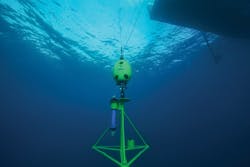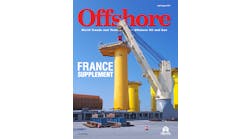Deepwater trials should start later this year of a new lightweight, observation-class ROV with autonomous docking capabilities. Forssea Robotics in Paris has been working on the development of the Atoll system since the company’s formation in 2016. One of its main goals is to devise new methods for reducing subsea operating costs.
Last September, Forssea secured funding of Eu2.4 million ($2.69 million) for the Atoll project from various sources, including the ‘Ship of the Future’ program managed by ADEME (the French Energy Agency), and the French investment bank BPI’s I-Lab competition. The company used some of the money for initial shallow-water trials of the ROV offshore La Ciotat, southern France.
Atoll is slightly larger than a typical observation class ROV, according to Forssea CEO Gautier Dreyfus, measuring 0.8 m (2.6 ft) in height and 1.1 m (3.6 ft) in width, with a weight in air of 200 kg. It is designed to be launched and recovered from a platform supply vessel (PSV) or light vessel of opportunity using a standard hydraulic A-frame. A 20-mm diameter tether connects the ROV to a clump weight which ensures alignment with the surface vessel of the 2,000-m (6,561-ft) long main lift umbilical. The vehicle can carry a payload of up to 25 kg and is also capable of lifting structures from the seafloor weighing up to 1.5 tons SWL.
At present, Atoll is designed primarily for deployment of long baseline (LBL) frames with latching systems for inspections of subsea production networks. But it can also dive autonomously toward a subsea target and subsequently connect to a docking station, using its embedded control algorithms. Once connected to the seafloor target, such as a wellhead or export line valve, it can perform power/data transfer for manipulation purposes, or if necessary retrieve the component to the surface for inspection or repair.
To support these tasks, the vehicle is equipped with a 75-kg horizontal thrust, a 50-kg vertical thrust, a 100-kW power transfer capacity, and a 1 Gbit/s data transfer rate (through one twisted shield pair and six single-mode optical fibers). Forssea can design the docking station for resident or non-permanent ROV operations.
Deepwater trials will be performed during a suitable weather window this summer or early in the fall in a water depth of around 1,000 m (3,281 ft), possibly at a location off France’s west coast, with a view to completing qualification of the technology by the end of this year. Assuming all goes to plan, the Atoll could then be ready to start its first deepwater field trial, possibly offshore West Africa. The forthcoming program will include simulations of typical subsea tasks and tests of acoustic sensors and will be witnessed by representatives of some of the major subsea contractors (Forssea does not intend to operate its own equipment, Gautier stressed).
Navigation, imaging and positioning specialist iXblue is supporting the development and the trials, proposing a new and more cost-effective method of LBL transponder array deployment and calibration. This would incorporate iXblue’s new autonomous survey vessel DriX, fitted with the company’s Gaps USBL with embedded inertial navigation system, to assist positioning of the Atoll and provide on-site calibration. DriX is designed to be deployed from iXblue’s own launch and recovery system DDS (DriX Deployment System), and from any light vessel equipped with a crane, Davit or A-frame.
According to Olivier Cervantes, VP Energy at iXblue: “The Canopus transponder fitted in the deployed frame comes as part of iXblue’s LBL solution, and provides new capabilities such as longer autonomy, using alkaline batteries, and easier configuration via WiFi on deck. Combining Atoll, DriX, and high-accuracy subsea positioning sensors is a flexible approach that does not require heavy logistical support. It also changes the way operators can make LBL deployments and calibration by saving vessel time, through use of a PSV instead of a light construction vessel. It can also provide savings of up to 70% compared to traditional methods.”
Forssea has formed academic partnerships with ENSTA Bretagne for subsea robotics and ISEN Brest for underwater vision, both in northwest France, and alliances with DeepOcean. It is also working on various other developments such as a smart ROV for observation/light intervention tasks, and control algorithms and augmented vision technologies that are said to be compatible with most existing ROVs and AUVs. Another development is a low-cost, fixed focus IP high definition camera which provides a wide horizontal angle of 100° in water to support ROV/AUV inspections, or alternatively, stereo-embedded vision. The camera is said to be fully calibrated with software lens distortion correction and can be adapted to AI and Computer Vision applications. •



